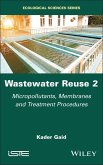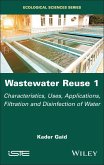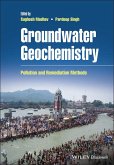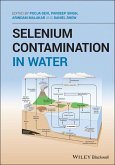Kader Gaid
Wastewater Reuse, Volume 2 (eBook, ePUB)
Micropollutants, Membranes and Treatment Procedures
143,99 €
143,99 €
inkl. MwSt.
Sofort per Download lieferbar

0 °P sammeln
143,99 €
Als Download kaufen

143,99 €
inkl. MwSt.
Sofort per Download lieferbar

0 °P sammeln
Jetzt verschenken
Alle Infos zum eBook verschenken
143,99 €
inkl. MwSt.
Sofort per Download lieferbar
Alle Infos zum eBook verschenken

0 °P sammeln
Kader Gaid
Wastewater Reuse, Volume 2 (eBook, ePUB)
Micropollutants, Membranes and Treatment Procedures
- Format: ePub
- Merkliste
- Auf die Merkliste
- Bewerten Bewerten
- Teilen
- Produkt teilen
- Produkterinnerung
- Produkterinnerung

Bitte loggen Sie sich zunächst in Ihr Kundenkonto ein oder registrieren Sie sich bei
bücher.de, um das eBook-Abo tolino select nutzen zu können.
Hier können Sie sich einloggen
Hier können Sie sich einloggen
Sie sind bereits eingeloggt. Klicken Sie auf 2. tolino select Abo, um fortzufahren.

Bitte loggen Sie sich zunächst in Ihr Kundenkonto ein oder registrieren Sie sich bei bücher.de, um das eBook-Abo tolino select nutzen zu können.
Water issues are inextricably linked to sustainable development since water must meet the needs of present and future generations.
The reuse of wastewater is a socioeconomic challenge for the development of drinking water and wastewater services. It has the following advantages: it increases usable water resources, preserves natural resources and alleviates water shortages caused by climate change.
Wastewater Reuse 2 provides a comprehensive and educational overview of the many ways wastewater can be reused, the variety of treatments, their performance, their conditions of use and how to…mehr
- Geräte: eReader
- mit Kopierschutz
- eBook Hilfe
- Größe: 42.84MB
Andere Kunden interessierten sich auch für
![Wastewater Reuse, Volume 2 (eBook, PDF) Wastewater Reuse, Volume 2 (eBook, PDF)]() Kader GaidWastewater Reuse, Volume 2 (eBook, PDF)143,99 €
Kader GaidWastewater Reuse, Volume 2 (eBook, PDF)143,99 €![Wastewater Reuse, Volume 1 (eBook, ePUB) Wastewater Reuse, Volume 1 (eBook, ePUB)]() Kader GaidWastewater Reuse, Volume 1 (eBook, ePUB)142,99 €
Kader GaidWastewater Reuse, Volume 1 (eBook, ePUB)142,99 €![Groundwater Geochemistry (eBook, ePUB) Groundwater Geochemistry (eBook, ePUB)]() Groundwater Geochemistry (eBook, ePUB)167,99 €
Groundwater Geochemistry (eBook, ePUB)167,99 €![Regional Water Security (eBook, ePUB) Regional Water Security (eBook, ePUB)]() Robert C. BrearsRegional Water Security (eBook, ePUB)125,99 €
Robert C. BrearsRegional Water Security (eBook, ePUB)125,99 €![Handbook of Water Harvesting and Conservation (eBook, ePUB) Handbook of Water Harvesting and Conservation (eBook, ePUB)]() Handbook of Water Harvesting and Conservation (eBook, ePUB)181,99 €
Handbook of Water Harvesting and Conservation (eBook, ePUB)181,99 €![Handbook of Water Harvesting and Conservation (eBook, ePUB) Handbook of Water Harvesting and Conservation (eBook, ePUB)]() Handbook of Water Harvesting and Conservation (eBook, ePUB)134,99 €
Handbook of Water Harvesting and Conservation (eBook, ePUB)134,99 €![Selenium Contamination in Water (eBook, ePUB) Selenium Contamination in Water (eBook, ePUB)]() Selenium Contamination in Water (eBook, ePUB)167,99 €
Selenium Contamination in Water (eBook, ePUB)167,99 €-
-
-
Water issues are inextricably linked to sustainable development since water must meet the needs of present and future generations.
The reuse of wastewater is a socioeconomic challenge for the development of drinking water and wastewater services. It has the following advantages: it increases usable water resources, preserves natural resources and alleviates water shortages caused by climate change.
Wastewater Reuse 2 provides a comprehensive and educational overview of the many ways wastewater can be reused, the variety of treatments, their performance, their conditions of use and how to combine them to give wastewater a new lease on life. Droughts are already a concern in many parts of the world; however, we now have new technologies to rely on.
The reuse of wastewater is a socioeconomic challenge for the development of drinking water and wastewater services. It has the following advantages: it increases usable water resources, preserves natural resources and alleviates water shortages caused by climate change.
Wastewater Reuse 2 provides a comprehensive and educational overview of the many ways wastewater can be reused, the variety of treatments, their performance, their conditions of use and how to combine them to give wastewater a new lease on life. Droughts are already a concern in many parts of the world; however, we now have new technologies to rely on.
Dieser Download kann aus rechtlichen Gründen nur mit Rechnungsadresse in D ausgeliefert werden.
Produktdetails
- Produktdetails
- Verlag: John Wiley & Sons
- Seitenzahl: 395
- Erscheinungstermin: 4. März 2025
- Englisch
- ISBN-13: 9781394361359
- Artikelnr.: 73584144
- Verlag: John Wiley & Sons
- Seitenzahl: 395
- Erscheinungstermin: 4. März 2025
- Englisch
- ISBN-13: 9781394361359
- Artikelnr.: 73584144
- Herstellerkennzeichnung Die Herstellerinformationen sind derzeit nicht verfügbar.
Kader Gaid is a professor at the University of Science and Technology Houari Boumediene, Algeria. He specializes in Environmental Process Engineering and was an expert at the utilities company Veolia in France for over 25 years.
Chapter 1 Case Studies with Tertiary Treatment 1
1.1 Limited urban use, irrigation of non-food or processed crops 4
1.1.1 Irrigation 4
1.1.2 Industrial reuse and recycling 6
1.1.3 Urban non-drinking water 6
1.1.4 Storage 7
1.2 Nosedo plant (Milan, Italy): irrigation 7
1.3 The Hermitage station (Reunion Island) 10
1.3.1 Pollutant loads 11
1.3.2 Tertiary filtration 12
1.3.3 UV disinfection 14
1.3.4 Educational aspect 18
1.4 The Barcelona plant (Spain): regeneration of wetlands, irrigation 18
1.5 Ajman (United Arab Emirates): irrigation and non-drinkable urban use 22
1.6 Al Wathba treatment plant (Abu Dhabi): recreational areas, green
spaces, industries 24
1.7 Burj Khalifa lake (Dubai): reuse wastewater for a recreational area 28
1.7.1 Treatment plant dimensions 29
1.8 Darling Quarter (Sydney, Australia): wastewater reuse in a neighborhood
32
1.9 References 35
Chapter 2 Micropollutants 47
2.1 Introduction 47
2.2 Pesticides 48
2.3 Pharmaceuticals and industrial residues 50
2.4 Technologies for removing pesticides and emerging micropollutants 58
2.4.1 Conventional oxidizers: chlorine, hypochlorite and chlorine dioxide
59
2.4.2 Advanced chemical oxidation 69
2.4.3 Activated carbon adsorption 74
2.4.4 Ozone/activated carbon combination 98
2.5 References 104
Chapter 3 Microfiltration and Ultrafiltration Membranes 109
3.1 Operating principle and mechanisms 111
3.1.1 Pressurized membranes 115
3.1.2 Submerged membranes 119
3.1.3 Filtration mode: frontal/tangential 122
3.2 Sizing parameters 123
3.2.1 Membrane selection 123
3.2.2 Cleaning in place 132
3.3 Microfiltration and ultrafiltration applied to wastewater treatment 133
3.3.1 Turbidity and TSS 133
3.3.2 Dissolved organic carbon 134
3.3.3 Energy consumption 134
3.4 Improved secondary treatment: membrane bioreactors 135
3.4.1 Suppliers of microfiltration membranes used in MBRs 139
3.4.2 Performance 142
3.5 Membrane layout in the reuse process 145
3.6 Hybrid process: combining chemical processes with MF/UF membranes 148
3.7 Conclusion 148
3.8 References 148
Chapter 4 Reverse Osmosis 155
4.1 Membranes 156
4.1.1 Materials 156
4.2 Principles of operation and separation 158
4.3 Wastewater treatment with reverse osmosis membranes 160
4.3.1 Parameters to consider when designing a treatment system 162
4.3.2 Sizing parameters 169
4.3.3 Post-treatment for drinking water supply 176
4.3.4 Disinfection downstream of membranes 176
4.4 Reverse osmosis in the wastewater reuse process 176
4.5 Performance 180
4.5.1 Pesticides 183
4.5.2 Drugs 186
4.5.3 Microorganisms 189
4.5.4 Water losses and energy consumption of membrane processes for water
reuse 190
4.6 Conclusion 191
4.7 References 192
Chapter 5 Applications for Drinking Water, Specific Industrial Water and
Groundwater Recharge 197
5.1 Windhoek: drinking water, specific industries and groundwater recharge
197
5.2 The Durban plant (South Africa) 203
5.2.1 For industrial use requiring rigorous quality 203
5.2.2 The wastewater reuse plant 207
5.2.3 Tertiary treatment sizing 207
5.2.4 Conclusion 217
5.3 Kranji (Singapore): irrigation, indirect drinking water, specific
industries 218
5.3.1 Sizing the Kranji plant 220
5.3.2 Performance 222
5.3.3 Conclusion 225
5.4 Illawarra (Australia): application, ocean protection, irrigation and
industry 226
5.4.1 Characteristics of wastewater treatment plants 228
5.4.2 Treatment processes 228
5.4.3 Conclusion 233
5.5 Honolulu: irrigation and industrial applications 234
5.6 Gerringong and Gerroa (Australia): controlled irrigation and beach
protection applications 237
5.6.1 Treatment process and guarantees 238
5.6.2 Microfiltration workshop 239
5.6.3 Conclusion 240
5.7 Playgrounds and leisure parks (France) 241
5.8 References 246
Chapter 6 What Does the Future Hold for Wastewater Reuse? 249
6.1 Challenges and prospects 249
6.2 What about drinking water? 253
6.3 Wastewater: Is it a real alternative? 253
6.4 References 256
Index 259
1.1 Limited urban use, irrigation of non-food or processed crops 4
1.1.1 Irrigation 4
1.1.2 Industrial reuse and recycling 6
1.1.3 Urban non-drinking water 6
1.1.4 Storage 7
1.2 Nosedo plant (Milan, Italy): irrigation 7
1.3 The Hermitage station (Reunion Island) 10
1.3.1 Pollutant loads 11
1.3.2 Tertiary filtration 12
1.3.3 UV disinfection 14
1.3.4 Educational aspect 18
1.4 The Barcelona plant (Spain): regeneration of wetlands, irrigation 18
1.5 Ajman (United Arab Emirates): irrigation and non-drinkable urban use 22
1.6 Al Wathba treatment plant (Abu Dhabi): recreational areas, green
spaces, industries 24
1.7 Burj Khalifa lake (Dubai): reuse wastewater for a recreational area 28
1.7.1 Treatment plant dimensions 29
1.8 Darling Quarter (Sydney, Australia): wastewater reuse in a neighborhood
32
1.9 References 35
Chapter 2 Micropollutants 47
2.1 Introduction 47
2.2 Pesticides 48
2.3 Pharmaceuticals and industrial residues 50
2.4 Technologies for removing pesticides and emerging micropollutants 58
2.4.1 Conventional oxidizers: chlorine, hypochlorite and chlorine dioxide
59
2.4.2 Advanced chemical oxidation 69
2.4.3 Activated carbon adsorption 74
2.4.4 Ozone/activated carbon combination 98
2.5 References 104
Chapter 3 Microfiltration and Ultrafiltration Membranes 109
3.1 Operating principle and mechanisms 111
3.1.1 Pressurized membranes 115
3.1.2 Submerged membranes 119
3.1.3 Filtration mode: frontal/tangential 122
3.2 Sizing parameters 123
3.2.1 Membrane selection 123
3.2.2 Cleaning in place 132
3.3 Microfiltration and ultrafiltration applied to wastewater treatment 133
3.3.1 Turbidity and TSS 133
3.3.2 Dissolved organic carbon 134
3.3.3 Energy consumption 134
3.4 Improved secondary treatment: membrane bioreactors 135
3.4.1 Suppliers of microfiltration membranes used in MBRs 139
3.4.2 Performance 142
3.5 Membrane layout in the reuse process 145
3.6 Hybrid process: combining chemical processes with MF/UF membranes 148
3.7 Conclusion 148
3.8 References 148
Chapter 4 Reverse Osmosis 155
4.1 Membranes 156
4.1.1 Materials 156
4.2 Principles of operation and separation 158
4.3 Wastewater treatment with reverse osmosis membranes 160
4.3.1 Parameters to consider when designing a treatment system 162
4.3.2 Sizing parameters 169
4.3.3 Post-treatment for drinking water supply 176
4.3.4 Disinfection downstream of membranes 176
4.4 Reverse osmosis in the wastewater reuse process 176
4.5 Performance 180
4.5.1 Pesticides 183
4.5.2 Drugs 186
4.5.3 Microorganisms 189
4.5.4 Water losses and energy consumption of membrane processes for water
reuse 190
4.6 Conclusion 191
4.7 References 192
Chapter 5 Applications for Drinking Water, Specific Industrial Water and
Groundwater Recharge 197
5.1 Windhoek: drinking water, specific industries and groundwater recharge
197
5.2 The Durban plant (South Africa) 203
5.2.1 For industrial use requiring rigorous quality 203
5.2.2 The wastewater reuse plant 207
5.2.3 Tertiary treatment sizing 207
5.2.4 Conclusion 217
5.3 Kranji (Singapore): irrigation, indirect drinking water, specific
industries 218
5.3.1 Sizing the Kranji plant 220
5.3.2 Performance 222
5.3.3 Conclusion 225
5.4 Illawarra (Australia): application, ocean protection, irrigation and
industry 226
5.4.1 Characteristics of wastewater treatment plants 228
5.4.2 Treatment processes 228
5.4.3 Conclusion 233
5.5 Honolulu: irrigation and industrial applications 234
5.6 Gerringong and Gerroa (Australia): controlled irrigation and beach
protection applications 237
5.6.1 Treatment process and guarantees 238
5.6.2 Microfiltration workshop 239
5.6.3 Conclusion 240
5.7 Playgrounds and leisure parks (France) 241
5.8 References 246
Chapter 6 What Does the Future Hold for Wastewater Reuse? 249
6.1 Challenges and prospects 249
6.2 What about drinking water? 253
6.3 Wastewater: Is it a real alternative? 253
6.4 References 256
Index 259
Chapter 1 Case Studies with Tertiary Treatment 1
1.1 Limited urban use, irrigation of non-food or processed crops 4
1.1.1 Irrigation 4
1.1.2 Industrial reuse and recycling 6
1.1.3 Urban non-drinking water 6
1.1.4 Storage 7
1.2 Nosedo plant (Milan, Italy): irrigation 7
1.3 The Hermitage station (Reunion Island) 10
1.3.1 Pollutant loads 11
1.3.2 Tertiary filtration 12
1.3.3 UV disinfection 14
1.3.4 Educational aspect 18
1.4 The Barcelona plant (Spain): regeneration of wetlands, irrigation 18
1.5 Ajman (United Arab Emirates): irrigation and non-drinkable urban use 22
1.6 Al Wathba treatment plant (Abu Dhabi): recreational areas, green
spaces, industries 24
1.7 Burj Khalifa lake (Dubai): reuse wastewater for a recreational area 28
1.7.1 Treatment plant dimensions 29
1.8 Darling Quarter (Sydney, Australia): wastewater reuse in a neighborhood
32
1.9 References 35
Chapter 2 Micropollutants 47
2.1 Introduction 47
2.2 Pesticides 48
2.3 Pharmaceuticals and industrial residues 50
2.4 Technologies for removing pesticides and emerging micropollutants 58
2.4.1 Conventional oxidizers: chlorine, hypochlorite and chlorine dioxide
59
2.4.2 Advanced chemical oxidation 69
2.4.3 Activated carbon adsorption 74
2.4.4 Ozone/activated carbon combination 98
2.5 References 104
Chapter 3 Microfiltration and Ultrafiltration Membranes 109
3.1 Operating principle and mechanisms 111
3.1.1 Pressurized membranes 115
3.1.2 Submerged membranes 119
3.1.3 Filtration mode: frontal/tangential 122
3.2 Sizing parameters 123
3.2.1 Membrane selection 123
3.2.2 Cleaning in place 132
3.3 Microfiltration and ultrafiltration applied to wastewater treatment 133
3.3.1 Turbidity and TSS 133
3.3.2 Dissolved organic carbon 134
3.3.3 Energy consumption 134
3.4 Improved secondary treatment: membrane bioreactors 135
3.4.1 Suppliers of microfiltration membranes used in MBRs 139
3.4.2 Performance 142
3.5 Membrane layout in the reuse process 145
3.6 Hybrid process: combining chemical processes with MF/UF membranes 148
3.7 Conclusion 148
3.8 References 148
Chapter 4 Reverse Osmosis 155
4.1 Membranes 156
4.1.1 Materials 156
4.2 Principles of operation and separation 158
4.3 Wastewater treatment with reverse osmosis membranes 160
4.3.1 Parameters to consider when designing a treatment system 162
4.3.2 Sizing parameters 169
4.3.3 Post-treatment for drinking water supply 176
4.3.4 Disinfection downstream of membranes 176
4.4 Reverse osmosis in the wastewater reuse process 176
4.5 Performance 180
4.5.1 Pesticides 183
4.5.2 Drugs 186
4.5.3 Microorganisms 189
4.5.4 Water losses and energy consumption of membrane processes for water
reuse 190
4.6 Conclusion 191
4.7 References 192
Chapter 5 Applications for Drinking Water, Specific Industrial Water and
Groundwater Recharge 197
5.1 Windhoek: drinking water, specific industries and groundwater recharge
197
5.2 The Durban plant (South Africa) 203
5.2.1 For industrial use requiring rigorous quality 203
5.2.2 The wastewater reuse plant 207
5.2.3 Tertiary treatment sizing 207
5.2.4 Conclusion 217
5.3 Kranji (Singapore): irrigation, indirect drinking water, specific
industries 218
5.3.1 Sizing the Kranji plant 220
5.3.2 Performance 222
5.3.3 Conclusion 225
5.4 Illawarra (Australia): application, ocean protection, irrigation and
industry 226
5.4.1 Characteristics of wastewater treatment plants 228
5.4.2 Treatment processes 228
5.4.3 Conclusion 233
5.5 Honolulu: irrigation and industrial applications 234
5.6 Gerringong and Gerroa (Australia): controlled irrigation and beach
protection applications 237
5.6.1 Treatment process and guarantees 238
5.6.2 Microfiltration workshop 239
5.6.3 Conclusion 240
5.7 Playgrounds and leisure parks (France) 241
5.8 References 246
Chapter 6 What Does the Future Hold for Wastewater Reuse? 249
6.1 Challenges and prospects 249
6.2 What about drinking water? 253
6.3 Wastewater: Is it a real alternative? 253
6.4 References 256
Index 259
1.1 Limited urban use, irrigation of non-food or processed crops 4
1.1.1 Irrigation 4
1.1.2 Industrial reuse and recycling 6
1.1.3 Urban non-drinking water 6
1.1.4 Storage 7
1.2 Nosedo plant (Milan, Italy): irrigation 7
1.3 The Hermitage station (Reunion Island) 10
1.3.1 Pollutant loads 11
1.3.2 Tertiary filtration 12
1.3.3 UV disinfection 14
1.3.4 Educational aspect 18
1.4 The Barcelona plant (Spain): regeneration of wetlands, irrigation 18
1.5 Ajman (United Arab Emirates): irrigation and non-drinkable urban use 22
1.6 Al Wathba treatment plant (Abu Dhabi): recreational areas, green
spaces, industries 24
1.7 Burj Khalifa lake (Dubai): reuse wastewater for a recreational area 28
1.7.1 Treatment plant dimensions 29
1.8 Darling Quarter (Sydney, Australia): wastewater reuse in a neighborhood
32
1.9 References 35
Chapter 2 Micropollutants 47
2.1 Introduction 47
2.2 Pesticides 48
2.3 Pharmaceuticals and industrial residues 50
2.4 Technologies for removing pesticides and emerging micropollutants 58
2.4.1 Conventional oxidizers: chlorine, hypochlorite and chlorine dioxide
59
2.4.2 Advanced chemical oxidation 69
2.4.3 Activated carbon adsorption 74
2.4.4 Ozone/activated carbon combination 98
2.5 References 104
Chapter 3 Microfiltration and Ultrafiltration Membranes 109
3.1 Operating principle and mechanisms 111
3.1.1 Pressurized membranes 115
3.1.2 Submerged membranes 119
3.1.3 Filtration mode: frontal/tangential 122
3.2 Sizing parameters 123
3.2.1 Membrane selection 123
3.2.2 Cleaning in place 132
3.3 Microfiltration and ultrafiltration applied to wastewater treatment 133
3.3.1 Turbidity and TSS 133
3.3.2 Dissolved organic carbon 134
3.3.3 Energy consumption 134
3.4 Improved secondary treatment: membrane bioreactors 135
3.4.1 Suppliers of microfiltration membranes used in MBRs 139
3.4.2 Performance 142
3.5 Membrane layout in the reuse process 145
3.6 Hybrid process: combining chemical processes with MF/UF membranes 148
3.7 Conclusion 148
3.8 References 148
Chapter 4 Reverse Osmosis 155
4.1 Membranes 156
4.1.1 Materials 156
4.2 Principles of operation and separation 158
4.3 Wastewater treatment with reverse osmosis membranes 160
4.3.1 Parameters to consider when designing a treatment system 162
4.3.2 Sizing parameters 169
4.3.3 Post-treatment for drinking water supply 176
4.3.4 Disinfection downstream of membranes 176
4.4 Reverse osmosis in the wastewater reuse process 176
4.5 Performance 180
4.5.1 Pesticides 183
4.5.2 Drugs 186
4.5.3 Microorganisms 189
4.5.4 Water losses and energy consumption of membrane processes for water
reuse 190
4.6 Conclusion 191
4.7 References 192
Chapter 5 Applications for Drinking Water, Specific Industrial Water and
Groundwater Recharge 197
5.1 Windhoek: drinking water, specific industries and groundwater recharge
197
5.2 The Durban plant (South Africa) 203
5.2.1 For industrial use requiring rigorous quality 203
5.2.2 The wastewater reuse plant 207
5.2.3 Tertiary treatment sizing 207
5.2.4 Conclusion 217
5.3 Kranji (Singapore): irrigation, indirect drinking water, specific
industries 218
5.3.1 Sizing the Kranji plant 220
5.3.2 Performance 222
5.3.3 Conclusion 225
5.4 Illawarra (Australia): application, ocean protection, irrigation and
industry 226
5.4.1 Characteristics of wastewater treatment plants 228
5.4.2 Treatment processes 228
5.4.3 Conclusion 233
5.5 Honolulu: irrigation and industrial applications 234
5.6 Gerringong and Gerroa (Australia): controlled irrigation and beach
protection applications 237
5.6.1 Treatment process and guarantees 238
5.6.2 Microfiltration workshop 239
5.6.3 Conclusion 240
5.7 Playgrounds and leisure parks (France) 241
5.8 References 246
Chapter 6 What Does the Future Hold for Wastewater Reuse? 249
6.1 Challenges and prospects 249
6.2 What about drinking water? 253
6.3 Wastewater: Is it a real alternative? 253
6.4 References 256
Index 259







